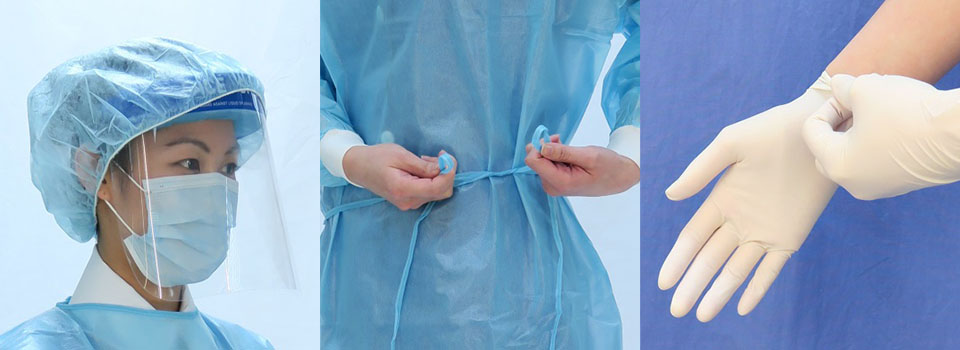Personal Protective Equipment (PPE)

The primary use of personal protective equipment (PPE) is to protect healthcare workers (HCWs) and reduce opportunities for transmission of microorganisms in healthcare facilities. It does not reduce the level of hazard itself nor guarantee total protection. They should be used as the supplement to the administration and engineering control in the care of the infective patients.
Care should be taken in both putting on clean PPE properly and timely removal of contaminated PPE without contamination of the staff themselves and the environment.
In infection control, PPE are frequently used to provide barrier between the infective pathogen and the healthcare worker. Commonly used PPE items include gloves, gown, mask, face shield/goggles, caps and foot protection.
According to Food and Drug Administration of the US (FDA), gowns are divided into medical and surgical isolation gown. There are different standards and requirements for gown, one of the most important aspect is water resistance level (AAMI 1-4) for different level of fluid exposure. Highest level of water resistance is adopted for Ebola virus disease and other hemorrhagic fevers.
Common types of mask used in healthcare settings are surgical masks and N95 respirator. Surgical masks offer good protection against droplet transmission if used properly. Wearer should take care not to mix up the layer facing outward and inward, otherwise the filtration efficiency and waterproof feature will be compromised. N95 respirator is used in settings with airborne transmitted infections e.g. measles, pulmonary tuberculosis and chickenpox. ‘N’ means non-oil-based (oil-based respirators are used in industrial settings involving organic solvents) and ‘95’ refers to the filtration efficiency of at least 95% of airborne particles. In order for an N95 respiratory to function effectively, wear must undergo fit test to choose the suitable model and perform fit check every time he/she puts on the respirator.
Gloves are used as part of the standard precaution dealing with blood or body fluids, or as part of the contact precautions. They are not a substitute for hand hygiene, and should be changed when broken, visibly contaminated or after finishing medical procedures. Prolonged wearing of the same pair of gloves may spread germs around as it gives the wear a false sense of security. Latex gloves may be prone to allergy. Nitrile gloves are more chemical-resistant. Heavy-duty rubber gloves are used in special circumstances to prevent injuries to hand.
In the past, powders were added to medical gloves to ease putting-on and enhance storage duration by manufacture. In 2016, FDA posed a medical device ban on powdered gloves on the basis that the powder can cause severe airway inflammation and hypersensitivity reactions. Powdered gloves are no longer recommended nowadays.
 14°C
14°C 20°C
20°C

 Top
Top